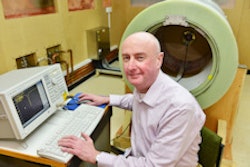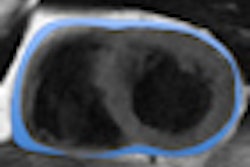A multidetector-row CT protocol that comprises coronary CT angiography (CCTA) and stress-rest perfusion delivers equivalent results to a cardiac MRI myocardial perfusion protocol for detecting functionally significant coronary artery disease (CAD), according to a new study in the Journal of the American College of Cardiology.
European researchers compared the diagnostic performance of this multidetector-row CT integrated protocol (MDCT-IP) with a cardiac MRI myocardial perfusion protocol (CMR perfusion) for detecting functionally significant disease in the same 101 patients with suspected CAD using fractional flow reserve as the reference standard. MDCT-IP demonstrated a global accuracy of 85% versus 88% for CMR perfusion, according to results that were close by every parameter measured by the investigators.
Each modality has strengths to overcome its weaknesses, according to Dr. Nuno Bettencourt and colleagues from Centro Hospitalar de Vila Nova de Gaia/Espinho in Lisbon, King's College London, and the Faculty of Medicine at the University of Porto in Portugal (JACC, 30 January 2013).
MDCT protocols integrating CCTA and stress-rest perfusion detect functionally significant CAD with similar accuracy as CMR perfusion, the authors concluded.
By itself CT perfusion (CTP) was inferior to CMR perfusion for diagnosing coronary artery disease, the authors noted. But adding the perfusion scan to CCTA increased CT's global accuracy for detecting functionally significant coronary artery disease in patients with intermediate-to-high pretest probability -- mainly due to an increase in specificity to the point where it reached rough equivalence with MRI.
CCTA "is particularly useful for the exclusion of [CAD] in patients with intermediate-to-low pretest probability, largely because of its high negative predictive value (NPV)," Bettencourt and colleagues wrote.
CCTA's limitations
However, the technique suffers from low specificity and positive predictive value (PPV), and decisions on the significance of MDCT findings generally involve additional studies, as the degree of stenosis is often overestimated, and the physiologic significance of many lesions remains uncertain, according to the authors.
In addition, CCTA's accuracy can be reduced by the presence of heavy calcifications, reducing its utility in patients with a higher pretest probability of disease. Studies have shown the value of combined CTP and CTA for detecting obstructive coronary artery disease in high-risk populations. But a comparison with established stress perfusion techniques such as CMR myocardial perfusion imaging and fractional flow reserve has been missing, according to the authors.
As a result, the researchers sought to compare the diagnostic accuracy of MDCT-IP with that of CMR perfusion for detecting significant coronary artery disease.
The study examined 101 symptomatic patients with suspected CAD (mean 62 ± 8 years, 67% men) and intermediate or high pretest probability of CAD using MDCT-IP, CMR perfusion, and invasive coronary angiography, all performed within about nine days of each other. Bettencourt and colleagues defined the presence of occlusive or subocclusive stenoses as fractional flow reserve measurements of 0.80 or higher in vessels 2 mm or larger.
CMR perfusion was performed on a 1.5-tesla system (Symphony, Siemens Healthcare) using a 12-channel coil. Three short-axis slices per heartbeat were acquired during injection of gadolinium (0.07 mmol/kg) using a gradient-echo sequence following adenosine injection and at rest. Cine images were obtained using a free-precession breath-hold sequence, followed by a late-enhancement gadolinium sequence 10 minutes after the last contrast injection, the authors reported.
The MDCT stress-rest exam was performed on a 64-detector-row scanner (Somatom Sensation, Siemens) after calcium scoring and injection of contrast (80 mL of iopromide) during adenosine infusion at 100 kV using modulation of the 600 mAs tube current at 60% to 65% of the RR interval and 0.6-mm collimation and reconstructed slice thickness. The group used intravenous metropolol as a beta-blocker when needed to slow the heartbeat to 60 beats per minute or less following the adenosine sequences. Mean radiation exposure was 5.0 ± 0.96 mSv (range, 3.7 to 8.9).
Good accuracy
The results yielded good accuracy for both approaches. Integration of CTP and CTA improved MDCT performance for detecting relevant coronary artery disease in intermediate-to-high pretest probability populations. Both CMR perfusion and MDCT-IP also showed excellent sensitivity and good specificity for detecting functionally significant coronary artery disease, with similar overall performance, according to Bettencourt and colleagues.
When CMR was used as a reference standard for CTP, isolated CTP showed a good overall accuracy of 82% for identifying perfusion defects detected at CMR, with sensitivity of 67% and specificity of 95%, the authors reported.
| Comparison of diagnostic protocols in detecting functionally significant CAD | |||||
| Sensitivity | Specificity | PPV | NPV | Accuracy | |
| Patient-based analysis (n = 101) | |||||
| CTA alone | 100% | 61% | 67% | 100% | 61% |
| CTP alone | 100% | 98% | 88% | 79% | 82% |
| MDCT-IP | 89% | 83% | 80% | 90% | 85% |
| CMR perfusion | 89% | 88% | 85% | 91% | 88% |
| Vessel-based analysis (n = 303) | |||||
| CTA alone | 95% | 67% | 48% | 97% | 74% |
| CTP alone | 55% | 95% | 78% | 87% | 85% |
| MDCT-IP | 71% | 90% | 68% | 91% | 85% |
| CMR perfusion | 79% | 93% | 79% | 93% | 90% |
Isolated CTP was globally inferior to CMR perfusion for diagnosing coronary artery disease but has the advantage of being highly specific, according to the researchers. In addition, adding CTP to CTA increases MDCT's global accuracy for detecting functionally significant coronary artery disease by improving specificity in patients with an intermediate to high pretest probability of disease.
"Based on our results, low-dose perfusion protocols might be ready for routine use in clinical practice, without a significant increase of radiation exposure, using standard 64-MDCT scanners: The entire MDCT protocol, including calcium scoring, CTA, and CTP is completed with an effective radiation exposure that represents less than one-half of the exposure usually reported for SPECT," Bettencourt and colleagues wrote. Nevertheless, "CMR has several advantages over MDCT for the detection of myocardial ischemia: It does not expose patients to ionizing radiation and provides dynamic real-time imaging of myocardial perfusion over the first passage of contrast."
For its part, CTP performed well in patients with or without ischemic scar, demonstrating that it can detect perfusion defects that represent true ischemia and not scar, and CTP's ability to discriminate functional relevance in patients with stenosis 40% or greater was superior to that of CT angiography. The use of a functional standard in the present study confirms the recent finding that adding CTP to CTA improves its diagnostic accuracy, "and highlights the advantage of functional and anatomic integration," the group wrote, adding that more advanced CT technology beyond what the 64-detector-row scanner used in the study affords may boost performance of MDCT-IP technique further.
But it's important to note that "CTP imaging is available today and yields important information missed by CTA alone," Bettencourt and colleagues concluded.



















